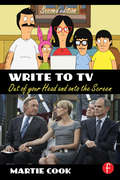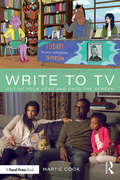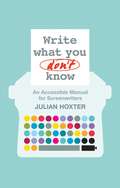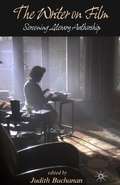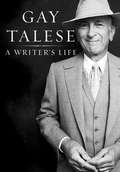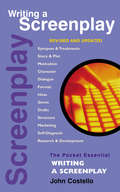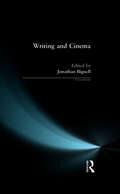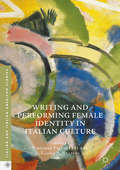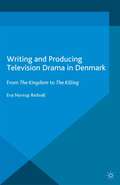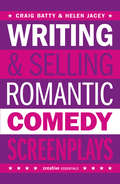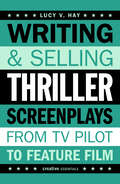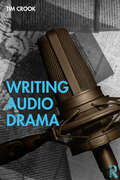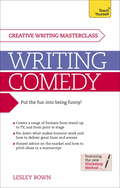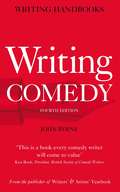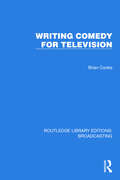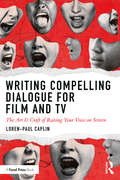- Table View
- List View
Write to TV: Out of Your Head and onto the Screen
by Martie CookLearn to craft smart, original stories and scripts for a variety of television formats and genres, including comedy, drama, pilots, animation, made-for-TV movies, late night, and reality television. Hear directly from studio and network executives, agents, and managers on what they’re looking for in new writers and how to avoid common pitfalls. Gain access to sample outlines, script pages, checklists, and countless other invaluable resources that will help you break into the industry and put you on the path to immediate success. In Write to TV, Second Edition industry veteran Martie Cook offers practical advice on writing innovative television scripts that will allow you to finally get that big idea out of your head and onto the screen. This new edition has been updated to include: Tips and techniques from industry vets Jay Leno, Norman Lear, Paul Haggis, David Magee, Susan Rovner, Tal Rabinowitz, Jonathan Littman, Peter Jankowski, Steve Stark, and Doug Herzog that you can immediately apply to your own projects Expanded coverage of writing pilots, pitching, writing webisodes, writing for tweens, writing for late night, and rewriting Useful advice for navigating the confusing television hierarchy, including how to network, get an agent, land that first writing job, and even "do lunch" 25 new interviews with writers and producers of hit shows such as New Girl, Parks and Recreation, The Blacklist, Curb Your Enthusiasm, CSI, The Tonight Show Starring Jimmy Fallon, and many more An all new companion website (www.writetotv.com) featuring blog updates, industry trends, a Q&A discussion forum with the author, and many other resources
Write to TV: Out of Your Head and onto the Screen
by Martie CookLearn to craft smart, original stories and scripts for a variety of television formats and genres, including comedy, drama, pilots, animation, made-for-TV movies, late night, and reality television. Hear directly from studio and network executives, agents, and managers on what they’re looking for in new writers and how to avoid common pitfalls. Gain access to sample outlines, script pages, checklists, and countless other invaluable resources that will help you break into the industry and put you on the path to immediate success. In Write to TV, Second Edition industry veteran Martie Cook offers practical advice on writing innovative television scripts that will allow you to finally get that big idea out of your head and onto the screen. This new edition has been updated to include: Tips and techniques from industry vets Jay Leno, Norman Lear, Paul Haggis, David Magee, Susan Rovner, Tal Rabinowitz, Jonathan Littman, Peter Jankowski, Steve Stark, and Doug Herzog that you can immediately apply to your own projects Expanded coverage of writing pilots, pitching, writing webisodes, writing for tweens, writing for late night, and rewriting Useful advice for navigating the confusing television hierarchy, including how to network, get an agent, land that first writing job, and even "do lunch" 25 new interviews with writers and producers of hit shows such as New Girl, Parks and Recreation, The Blacklist, Curb Your Enthusiasm, CSI, The Tonight Show Starring Jimmy Fallon, and many more An all new companion website (www.writetotv.com) featuring blog updates, industry trends, a Q&A discussion forum with the author, and many other resources
Write to TV: Out of Your Head and onto the Screen
by Martie CookIn Write to TV (third edition) industry veteran Martie Cook offers practical advice on writing innovative television scripts that will allow you to finally get that big idea out of your head and onto the screen. With this book you’ll learn to craft smart, original stories and scripts for a variety of television formats and genres, including comedy, drama, pilots, web series, and subscription video on demand. This new edition has been updated with expanded coverage on writing for global audiences, content creation for streaming services such as Netflix, Amazon and Hulu, as well as writing the web series, podcasts and utilizing free platforms such as YouTube. It also features new chapters on writing for niche markets; breaking into the writers’ room; creating binge-worthy series and how to accompany pilot scripts with a series pitch document. Plus, expanded information on creating complex and compelling characters including writing anti-heroes and strong female protagonists and much, much more. Including information directly from studio and network executives, agents, and managers on what they’re looking for in new writers and how to avoid common pitfalls, advice from successful creators and showrunners on creating original content that sells, and tips from new writers on how to get into a writers room and stay there. This book contains information from more than 20 new interviews, access to sample outlines, script pages, checklists, and countless other invaluable resources, and is the ideal book for anyone who wants to break into the TV writing industry.
Write to TV: Out of Your Head and onto the Screen
by Martie CookIn Write to TV (third edition) industry veteran Martie Cook offers practical advice on writing innovative television scripts that will allow you to finally get that big idea out of your head and onto the screen. With this book you’ll learn to craft smart, original stories and scripts for a variety of television formats and genres, including comedy, drama, pilots, web series, and subscription video on demand. This new edition has been updated with expanded coverage on writing for global audiences, content creation for streaming services such as Netflix, Amazon and Hulu, as well as writing the web series, podcasts and utilizing free platforms such as YouTube. It also features new chapters on writing for niche markets; breaking into the writers’ room; creating binge-worthy series and how to accompany pilot scripts with a series pitch document. Plus, expanded information on creating complex and compelling characters including writing anti-heroes and strong female protagonists and much, much more. Including information directly from studio and network executives, agents, and managers on what they’re looking for in new writers and how to avoid common pitfalls, advice from successful creators and showrunners on creating original content that sells, and tips from new writers on how to get into a writers room and stay there. This book contains information from more than 20 new interviews, access to sample outlines, script pages, checklists, and countless other invaluable resources, and is the ideal book for anyone who wants to break into the TV writing industry.
Write What You Don't Know: An Accessible Manual for Screenwriters
by Julian HoxterWrite What You Don't Know is a friendly manual for aspiring screenwriters. It encourages you to move beyond your comfort zones in search of stories. We all write what we know - how could we not? Writing what you don't know and doing it in an informed and imaginative way is what makes the process worthwhile. Hoxter draws on his wealth of experience teaching young film students to offer help with every aspect of the writing process, including how we come up with ideas in the first place. Light hearted and full of insight into the roundabout way film students approach their scripts, it also discusses the important issues like the difference between stories and plots and what your characters should be doing in the middle of act two. Write What You Don't Know contains examples and case studies from a wide range of movies, both mainstream and alternative such as The Virgin Spring, Die Hard, The Ipcress File, For The Birds, (500) Days of Summer, Juno, Up In The Air, Knocked Up and Brick.
Write What You Don't Know: An Accessible Manual for Screenwriters
by Julian HoxterWrite What You Don't Know is a friendly manual for aspiring screenwriters. It encourages you to move beyond your comfort zones in search of stories. We all write what we know - how could we not? Writing what you don't know and doing it in an informed and imaginative way is what makes the process worthwhile. Hoxter draws on his wealth of experience teaching young film students to offer help with every aspect of the writing process, including how we come up with ideas in the first place. Light hearted and full of insight into the roundabout way film students approach their scripts, it also discusses the important issues like the difference between stories and plots and what your characters should be doing in the middle of act two. Write What You Don't Know contains examples and case studies from a wide range of movies, both mainstream and alternative such as The Virgin Spring, Die Hard, The Ipcress File, For The Birds, (500) Days of Summer, Juno, Up In The Air, Knocked Up and Brick.
The Writer on Film: Screening Literary Authorship
by Judith BuchananExamining films about writers and acts of writing, The Writer on Film brilliantly refreshes some of the well-worn 'adaptation' debates by inviting film and literature to engage with each other trenchantly and anew – through acts of explicit configuration not adaptation.
A Writer's Life
by Gay TaleseHow has Gay Talese found his subjects? How has he gotten them onto the page? What drives him to write? These are some of the questions at the heart of the narrative that combines memory, reflection, explanation and a satisfying obsession. I his trademark prose - precise, beautifully crafted, elegant - Talese traces the paths his passionate interests have made through his life and writing. He talks about first becoming absorbed in issues of race as a student in Alabama, about covering the civil rights struggle and about a recent interracial wedding in Selma. He reflects on the changing American sexual mores he has written about over the last 50 years, and gives an incisive examination of the lives of Lorena and John Bobbitt. He talks about his legendary Esquire profile of Frank Sinatra - judged by the magazine to be the finest in its long history - and about the ordinary men and women whose stories led to some of his most memorable work. And as he delves into the life of a young female Chinese soccer player, we see his consuming interest in the world in its latest manifestation. In these and other recollections and stories, he gives us a fascinating picture of both the serendipity and meticulousness involved in getting a story, and getting it right.Candid, humorous, deeply impassioned - a dazzling book about the nature of writing in one man's life, and of writing itself.
Writing a Screenplay (Pocket Essentials Ser.)
by John CostelloThe recent explosion of unsolicited material written for the world's greatest, sexiest entertainment medium has largely produced a mountain of wasted paper. Truth is, the many who write from scratch, no matter how talented, have more chance of winning the lottery than creating an excellent script. The few who achieve success do so because they have shed the blood, sweat and tears necessary to master the elaborate art and craft of Screenwriting. This book explodes the myth that a screenplay is the easiest literary form to master, navigates a relatively painless path through the Screenwriting labyrinth, and offers an easy to digest step-by-step guide to writing a script from inception to completion. What's in it? The main areas covered are: Motivation; Research & Development; Genre; Idea; Story & Plot; Audience; Character; Action & Setting; Structure; Format; Dialogue; Synopses & Treatments; Drafts; Marketing & The Industry. There's also a glossary of commonly used jargon to further demystify the process.
Writing and Cinema (Crosscurrents)
by Jonathan BignellThis collection of essays examines the ways in which writing and cinema can be studied in relation to each other. A wide range of material is presented, from essays which look at particular films, including The Piano and The English Patient, to discussions of the latest developments in film studies including psychoanalytic film theory and the cultural study of film audiences. Specific topics that the essays address also include: the kinds of writing produced for the cinema industry, advertising, film adaptations of written texts and theatre plays from nineteenth century 'classic' novels to recent cyberpunk science fiction such as Blade Runner and Starship Troopers. The essays deal with existing areas of debate, like questions of authorship and audience, and also break new ground, for example in proposing approaches to the study of writing on the cinema screen. The book includes a select bibliography, and a documents section gives details of a range of films for further study.
Writing and Cinema (Crosscurrents)
by Jonathan BignellThis collection of essays examines the ways in which writing and cinema can be studied in relation to each other. A wide range of material is presented, from essays which look at particular films, including The Piano and The English Patient, to discussions of the latest developments in film studies including psychoanalytic film theory and the cultural study of film audiences. Specific topics that the essays address also include: the kinds of writing produced for the cinema industry, advertising, film adaptations of written texts and theatre plays from nineteenth century 'classic' novels to recent cyberpunk science fiction such as Blade Runner and Starship Troopers. The essays deal with existing areas of debate, like questions of authorship and audience, and also break new ground, for example in proposing approaches to the study of writing on the cinema screen. The book includes a select bibliography, and a documents section gives details of a range of films for further study.
Writing and Performing Female Identity in Italian Culture
by Virginia Picchietti Laura A. SalsiniThis volume investigates the ways in which Italian women writers, filmmakers, and performers have represented female identity across genres from the immediate post-World War II period to the turn of the twenty-first century. Considering genres such as prose, poetry, drama, and film, these essays examine the vision of female agency and self-actualization arising from women artists’ critique of female identity. This dual approach reveals unique interpretations of womanhood in Italy spanning more than fifty years, while also providing a deep investigation of the manipulation of canvases historically centered on the male subject. With its unique coupling of generic and thematic concerns, the volume contributes to the ever expanding female artistic legacy, and to our understanding of postwar Italian women’s evolving relationship to the narration of history, gender roles, and these artists’ use and revision of generic convention to communicate their vision.
Writing and Performing Female Identity in Italian Culture
by Virginia Picchietti Laura A. SalsiniThis volume investigates the ways in which Italian women writers, filmmakers, and performers have represented female identity across genres from the immediate post-World War II period to the turn of the twenty-first century. Considering genres such as prose, poetry, drama, and film, these essays examine the vision of female agency and self-actualization arising from women artists’ critique of female identity. This dual approach reveals unique interpretations of womanhood in Italy spanning more than fifty years, while also providing a deep investigation of the manipulation of canvases historically centered on the male subject. With its unique coupling of generic and thematic concerns, the volume contributes to the ever expanding female artistic legacy, and to our understanding of postwar Italian women’s evolving relationship to the narration of history, gender roles, and these artists’ use and revision of generic convention to communicate their vision.
Writing and Producing Television Drama in Denmark: From The Kingdom to The Killing (Palgrave Studies in Screenwriting)
by Eva Novrup RedvallOffering unique insights into the writing and production of television drama series such as The Killing and Borgen, produced by DR, the Danish Broadcasting Corporation, Novrup Redvall explores the creative collaborations in writers' rooms and 'production hotels' through detailed case studies of Denmark's public service production culture.
Writing and Selling Romantic Comedy Screenplays: A Screenwriter's Guide to the RomCom Genre (Writing And Selling Screenplays Ser.)
by Helen JaceyWhat happens when ‘happy ever after’ isn’t quite so simple?Today’s attitudes to love and romance are as varied and diverse as individuals, and audiences want and need more sophisticated, authentic films that show how we live and love now. So what does this mean for the screenwriter developing a romcom? And how do they write heart-warming stories for a genre that is constantly evolving, from bromcom to zomcom to famcom?Writing and Selling Romantic Comedy Screenplays offers a fresh approach to creating narratives for this ever-changing genre. Moving away from rigid and limited definitions that have evolved out of mainstream genre films, the book embraces a working definition that crosses cultural and national boundaries to give screenwriters around the world a truly international perspective on writing comedic love stories.It is the first screenwriting guide to reflect the diversity of approaches in today’s films that deal with the human need for emotional and physical intimacy using humour – the contemporary romantic comedy.'Immensely helpful' - Divya Johry 'An excellent addition to the Creative Essentials screenwriting book family' - WritesSoFluidFeatures of the book include:Illuminating, challenging and provocative about the state of the rom-com genre. Why do some films feel so dated, while others are perennially relevant?Explores and defines all subgenres of romcom, such as zomcom, bromedy, soromcom and famcom.Uniquely draws on creativity, screenwriting genre theory and film industry practice. Stimulating creative exercises at the end of every chapter, and 'hot tips' throughout.Adaptable concepts that can be applied to both feature films and short films.Encourages screenwriters to define their own values about love to ensure their voice and message is original - and commercial.Case studies and analyses of produced screenplays, including Dostana, Due Date, I Give it a Year, I love You, Man, Midnight in Paris, Ruby Sparks, Tamara Drewe, Ted and Warm BodiesInterviews with writers, directors and producers.Genuine international perspectiveIndispensible guide for both the student and the professional writer or filmmaker.
Writing and Selling Thriller Screenplays: A Screenwriter's Guide for Film and Television (Writing And Selling Screenplays Ser.)
by Lucy V. HayWriting and Selling Thriller Screenplays has the lowdown not only on getting your thriller feature script on the page, but getting it in front of producers and investors.From premise to resolution, Lucy V. Hay guides you through the craft of thriller writing, citing classic thrillers such as Psycho, The Shining, The Sixth Sense and Fatal Attraction and lesser-known gems like Red Eye, Desperate Measures, Impostor and Deviation.The book also considers how the screenplay might be sold to investors, looking at high concept ideas, pitching, packaging and the realities of film finance.Lucy V. Hay asks: what is flight vs. fight? What is the difference between horror and thriller? What are the different sub genres of thriller? What part do actors play in film finance? How can limited locations create new opportunities in storytelling and financing? Why is the lone protagonist so in demand? Why are female characters so popular in thriller? And much, much more...'Really hones in on the specific genre of thrillers with expertise' - Write So Fluid'A must-read for any writer, producer or director looking to create (or in the process of creating) a thriller production. It could also be immensely useful for those generally curious about the genre or looking to learn more' - Film Doctor'This book should form part of the armoury for any screenplay writers bookshelf' - Stephen HallCheck out Lucy V. Hay's other screenwriting books: Writing & Selling Drama Screenplays and Writing Diverse Characters for Fiction, Film and TV
Writing Audio Drama
by Tim CrookWriting Audio Drama is a comprehensive and intelligent guide to writing sound drama for broadcasting and online production. The book uses new and original research on the history of writing radio plays in the UK and USA to explore how this has informed and developed the art form for more than 100 years. Audio drama in the context of podcasting is now experiencing a global and exponential expansion. Through analysis of examples of past and present writing, the author explains how to originate and craft drama which can explore deeply psychological and intimate themes and achieve emotional, truthful, entertaining, and thought-provoking impact. Practical analysis of the key factors required to write successful audio drama is covered in chapters focusing on audio play beginnings and openings, sound story dialogue, sustaining the sound story, plotting for sound drama and the best ways of ending audio plays. Each chapter is supported by extensive companion online resources expanding and supporting the writers and subjects discussed and explored, and extensive information on how to access online many exemplar and model sound dramas referenced in the chapters. This textbook will be an important resource for undergraduate and postgraduate students taking modules and courses on radio drama, theatre and media drama, audio theatre, audio drama, scriptwriting, media writing.
Writing Audio Drama
by Tim CrookWriting Audio Drama is a comprehensive and intelligent guide to writing sound drama for broadcasting and online production. The book uses new and original research on the history of writing radio plays in the UK and USA to explore how this has informed and developed the art form for more than 100 years. Audio drama in the context of podcasting is now experiencing a global and exponential expansion. Through analysis of examples of past and present writing, the author explains how to originate and craft drama which can explore deeply psychological and intimate themes and achieve emotional, truthful, entertaining, and thought-provoking impact. Practical analysis of the key factors required to write successful audio drama is covered in chapters focusing on audio play beginnings and openings, sound story dialogue, sustaining the sound story, plotting for sound drama and the best ways of ending audio plays. Each chapter is supported by extensive companion online resources expanding and supporting the writers and subjects discussed and explored, and extensive information on how to access online many exemplar and model sound dramas referenced in the chapters. This textbook will be an important resource for undergraduate and postgraduate students taking modules and courses on radio drama, theatre and media drama, audio theatre, audio drama, scriptwriting, media writing.
Writing Comedy: How to use funny plots and characters, wordplay and humour in your creative writing
by Lesley BownLearn how to write comedy that makes people laugh.Masterclass: Writing Comedy will reveal to both beginners and experienced writers the distinctive features that mark out comedy from other forms of creative writing. Having identified these, it will help you then to unlock your inner anarchist, and explore the different elements of comedy, using a combination of practical exercises, insight and creative inspiration. Whatever your preferred comic genre, you will find guidance on everything from wordplay and visual humour to plots, comedy characters and different styles.A section on performance will help you to hone stand-up skills, while chapters on stage and screen will give techniques and tips on how to craft a sitcom or create a sketch show. Finally, there is a uniquely frank but useful section on the realities of the markets, and the actualities of going it alone with self-publishing and self-promotion - or the tools you need to successfully pitch an idea or comic manuscript.ABOUT THE SERIESThe Teach Yourself Creative Writing series helps aspiring authors tell their stories. Covering a range of genres from science fiction and romantic novels to illustrated children's books and comedy, this series is packed with advice, exercises, and tips for unlocking creativity and improving your writing. And because we know how daunting the blank page can be, we set up the Just Write online community, at tyjustwrite.com, for budding authors and successful writers to connect and share.
Writing Comedy
by John ByrneComedy has always been one of the most high-profile, glamorous and potentially lucrative markets for scriptwriters, but it is also perceived as one of the hardest. In the fourth edition of this highly regarded handbook, John Byrne breaks down the basics of writing comedy into simple steps and shows you how to make the most of your own comedy writing talent and - just as importantly - your ability to market that talent.Here is a wealth of practical advice both on how to get your career off the ground and how to keep developing it. Whether you are writing comedy routines, sketches or sitcoms, and aiming your work at the page, the stage or the ever-expanding world of broadcasting, you will find something in this book to encourage, inform and inspire you.As with any art form, the basics of good comedy never go out of fashion. While the easy steps in this book are illustrated with examples of work by classic comedians old and new, you will also find useful advice on developing and adapting your work for the twenty-first century market, whether your aim is to promote your work online or simply to keep your gags fresh and topical in a world where the news changes by the minute and gets flashed around the world in seconds.
Writing Comedy (Writing Handbooks Ser. #41)
by John ByrneComedy has always been one of the most high-profile, glamorous and potentially lucrative markets for scriptwriters, but it is also perceived as one of the hardest. In the fourth edition of this highly regarded handbook, John Byrne breaks down the basics of writing comedy into simple steps and shows you how to make the most of your own comedy writing talent and - just as importantly - your ability to market that talent.Here is a wealth of practical advice both on how to get your career off the ground and how to keep developing it. Whether you are writing comedy routines, sketches or sitcoms, and aiming your work at the page, the stage or the ever-expanding world of broadcasting, you will find something in this book to encourage, inform and inspire you.As with any art form, the basics of good comedy never go out of fashion. While the easy steps in this book are illustrated with examples of work by classic comedians old and new, you will also find useful advice on developing and adapting your work for the twenty-first century market, whether your aim is to promote your work online or simply to keep your gags fresh and topical in a world where the news changes by the minute and gets flashed around the world in seconds.
Writing Comedy for Television (Routledge Library Editions: Broadcasting #40)
by Brian CookeWriting Comedy for Television (1983) is a practical, step-by-step manual about how and what to write. It contains many examples from the scripts of various sitcoms and sketch shows. It demonstrates how to construct a storyline for a series, how to lay out a sketch, who to pitch to, and how a television comedy is put together.
Writing Comedy for Television (Routledge Library Editions: Broadcasting #40)
by Brian CookeWriting Comedy for Television (1983) is a practical, step-by-step manual about how and what to write. It contains many examples from the scripts of various sitcoms and sketch shows. It demonstrates how to construct a storyline for a series, how to lay out a sketch, who to pitch to, and how a television comedy is put together.
Writing Compelling Dialogue for Film and TV: The Art & Craft of Raising Your Voice on Screen
by Loren-Paul CaplinWriting Compelling Dialogue for Film and TV is a practical guide that provides you, the screenwriter, with a clear set of exercises, tools, and methods to raise your ability to hear and discern conversation at a more complex level, in turn allowing you to create better, more nuanced, complex and compelling dialogue. The process of understanding dialogue writing begins with increasing writers’ awareness of what they hear. This book provides writers with an assortment of dialogue and language tools, techniques, and exercises and teaches them how to perceive and understand the function, intent and thematic/psychological elements that dialogue can convey about character, tone, and story. Text, subtext, voice, conflict, exposition, rhythm and style are among the many aspects covered. This book reminds us of the sheer joy of great dialogue and will change and enhance the way writers hear, listen to, and write dialogue, and along the way aid the writers’ confidence in their own voice allowing them to become more proficient writers of dialogue. Written by veteran screenwriter, playwright, and screenwriting professor Loren-Paul Caplin, Writing Compelling Dialogue is an invaluable writing tool for any aspiring screenwriter who wants to improve their ability to write dialogue for film and television, as well as students, professionals, and educators.
Writing Compelling Dialogue for Film and TV: The Art & Craft of Raising Your Voice on Screen
by Loren-Paul CaplinWriting Compelling Dialogue for Film and TV is a practical guide that provides you, the screenwriter, with a clear set of exercises, tools, and methods to raise your ability to hear and discern conversation at a more complex level, in turn allowing you to create better, more nuanced, complex and compelling dialogue. The process of understanding dialogue writing begins with increasing writers’ awareness of what they hear. This book provides writers with an assortment of dialogue and language tools, techniques, and exercises and teaches them how to perceive and understand the function, intent and thematic/psychological elements that dialogue can convey about character, tone, and story. Text, subtext, voice, conflict, exposition, rhythm and style are among the many aspects covered. This book reminds us of the sheer joy of great dialogue and will change and enhance the way writers hear, listen to, and write dialogue, and along the way aid the writers’ confidence in their own voice allowing them to become more proficient writers of dialogue. Written by veteran screenwriter, playwright, and screenwriting professor Loren-Paul Caplin, Writing Compelling Dialogue is an invaluable writing tool for any aspiring screenwriter who wants to improve their ability to write dialogue for film and television, as well as students, professionals, and educators.
